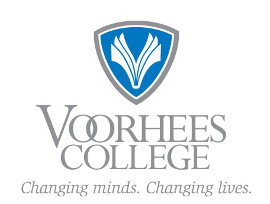S.C. Encyclopedia | Located in Denmark, Voorhees College is a four-year liberal arts undergraduate institution. Founded in 1897 by Elizabeth Evelyn Wright and Jessie Dorsey, the school was first known as the Denmark Industrial School and was based on Booker T. Washington’s Tuskegee Institute. Wright was Washington’s protégée and had determined that she wanted to “be the same type of woman as Mr. Washington was of a man.” On graduation she set out for South Carolina to develop a second Tuskegee.
 Wright’s first efforts at Govan and in Hampton County were thwarted by a hostile white community, which burned buildings and building materials. Undaunted, Wright approached state senator Stanwix G. Mayfield of Bamberg County, who sold her twenty acres of land after she obtained an endorsement from Washington and collected pennies and nickels from black churches. The Denmark Industrial School became a reality when Wright and Dorsey taught 14 boarders and 236 pupils in the upstairs of an abandoned store. The curriculum included the basics of reading, writing, and arithmetic, but the school’s primary mission was to develop students through an industrial-vocational system modeled after Tuskegee.
Wright’s first efforts at Govan and in Hampton County were thwarted by a hostile white community, which burned buildings and building materials. Undaunted, Wright approached state senator Stanwix G. Mayfield of Bamberg County, who sold her twenty acres of land after she obtained an endorsement from Washington and collected pennies and nickels from black churches. The Denmark Industrial School became a reality when Wright and Dorsey taught 14 boarders and 236 pupils in the upstairs of an abandoned store. The curriculum included the basics of reading, writing, and arithmetic, but the school’s primary mission was to develop students through an industrial-vocational system modeled after Tuskegee.
By 1902 Wright had successfully persuaded a New Jersey industrialist, Ralph Voorhees, to donate money that was used to purchase land and construct buildings. The institution was renamed for its benefactor, and the state legislature incorporated the school in 1904 as the Voorhees Industrial School for Colored Youths. The school now had almost 350 students and 17 faculty members and was supported by the local black community as well as through solicitation campaigns. Though Wright died in 1906, the school continued to prosper. By the end of World War I, however, Voorhees faced a financial crisis when gifts and grants decreased. In 1924 the school was taken over by the Episcopal Church’s American Institute for Negroes and remains affiliated with the Diocese of South Carolina.
The school’s name was changed in 1947 to Voorhees School and Junior College, and in 1962 it became Voorhees College. Earning full accreditation as a four-year school from the Southern Association of Colleges and Schools in 1968, Voorhees faced student unrest over civil rights and personnel issues. Voorhees students objected to the lack of blacks serving on the school’s board of trustees as well as student living conditions, wage scales for nonacademic workers, few black history courses, and a poorly equipped library. With tempers rising and protests growing, armed students took over the library in April 1969. The demonstration was reported in the national press but ended quickly when the National Guard was called to the campus by President John Potts and J. Kenneth Morris, chairman of the board of trustees.
Potts’s tenure as president of Voorhees from 1954 to 1970 was marked by both progress and protest. During that time the institution dropped its high school component and became a four-year college. Other accomplishments included increased enrollment, an improvement in the quality of the faculty, and an upgrading of the curriculum and programs. Several presidents who succeeded Potts did not prove to be as visionary in dealing with programs, finances, or students and were dismissed from office. Enrollment reached a high of one thousand students in 1976. In 2001 Voorhees had seven hundred students when it welcomed its seventh president, Dr. Lee Monroe. The college offers a traditional liberal arts program and awards bachelor’s degrees in eleven majors.
NOTE: Dr. Cleveland Sellers is the college’s current president. Founder Elizabeth Evelyn Wright is an honoree on AT&T’s 27th annual S.C. African American History Calendar for 2016.
– Excerpted from the entry by Louise Allen. To read more about this or 2,000 other entries about South Carolina, check out The South Carolina Encyclopedia by USC Press. (Information used by permission.)



 We Can Do Better, South Carolina!
We Can Do Better, South Carolina!
























